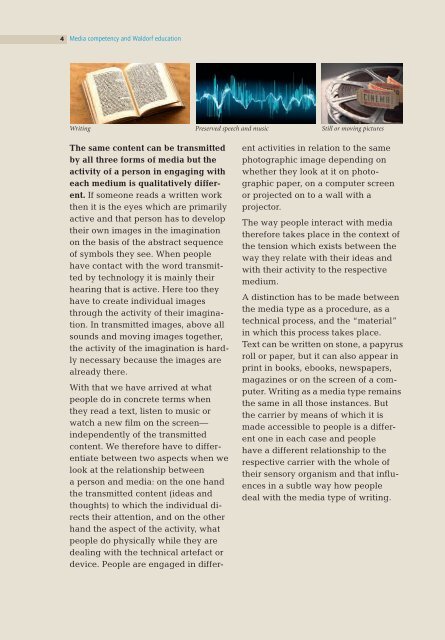Struwwelpeter 2.0
Struwwelpeter_engl_August_2015
Struwwelpeter_engl_August_2015
- No tags were found...
You also want an ePaper? Increase the reach of your titles
YUMPU automatically turns print PDFs into web optimized ePapers that Google loves.
4<br />
Media competency and Waldorf education<br />
Writing Preserved speech and music Still or moving pictures<br />
The same content can be transmitted<br />
by all three forms of media but the<br />
activity of a person in engaging with<br />
each medium is qualitatively different.<br />
If someone reads a written work<br />
then it is the eyes which are primarily<br />
active and that person has to develop<br />
their own images in the imagination<br />
on the basis of the abstract sequence<br />
of symbols they see. When people<br />
have contact with the word transmitted<br />
by technology it is mainly their<br />
hearing that is active. Here too they<br />
have to create individual images<br />
through the activity of their imagination.<br />
In transmitted images, above all<br />
sounds and moving images together,<br />
the activity of the imagination is hardly<br />
necessary because the images are<br />
already there.<br />
With that we have arrived at what<br />
people do in concrete terms when<br />
they read a text, listen to music or<br />
watch a new film on the screen—<br />
independently of the transmitted<br />
content. We therefore have to differentiate<br />
between two aspects when we<br />
look at the relationship between<br />
a person and media: on the one hand<br />
the transmitted content (ideas and<br />
thoughts) to which the individual directs<br />
their attention, and on the other<br />
hand the aspect of the activity, what<br />
people do physically while they are<br />
dealing with the technical artefact or<br />
device. People are engaged in different<br />
activities in relation to the same<br />
photographic image depending on<br />
whether they look at it on photographic<br />
paper, on a computer screen<br />
or projected on to a wall with a<br />
projector.<br />
The way people interact with media<br />
therefore takes place in the context of<br />
the tension which exists between the<br />
way they relate with their ideas and<br />
with their activity to the respective<br />
medium.<br />
A distinction has to be made between<br />
the media type as a procedure, as a<br />
technical process, and the “material”<br />
in which this process takes place.<br />
Text can be written on stone, a papyrus<br />
roll or paper, but it can also appear in<br />
print in books, ebooks, newspapers,<br />
magazines or on the screen of a computer.<br />
Writing as a media type remains<br />
the same in all those instances. But<br />
the carrier by means of which it is<br />
made accessible to people is a different<br />
one in each case and people<br />
have a different relationship to the<br />
respective carrier with the whole of<br />
their sensory organism and that influences<br />
in a subtle way how people<br />
deal with the media type of writing.


